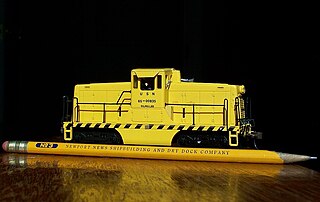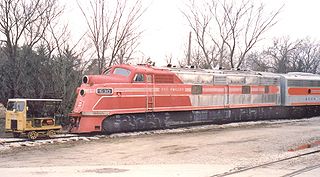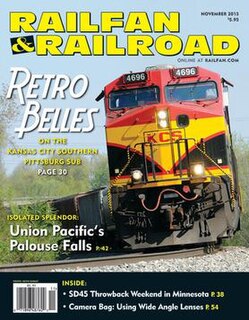Related Research Articles

HO or H0 is a rail transport modelling scale using a 1:87 scale. It is the most popular scale of model railway in the world. The rails are spaced 16.5 millimetres (0.650 in) apart for modelling 1,435 mm standard gauge tracks and trains in HO.

Model Railroader (MR) is an American magazine about the hobby of model railroading. Founded in 1934 by Al C. Kalmbach, it is published monthly by Kalmbach Media of Waukesha, Wisconsin. Commonly found on newsstands and in libraries, it promotes itself as the oldest magazine of its type in the United States, although it is the long-standing competitor to Railroad Model Craftsman, which - originally named The Model Craftsman - predates MR by one year.

Railroad Model Craftsman is an American magazine specializing in the hobby of model railroading. The magazine is published monthly by White River Productions, which acquired the title from Carstens Publications in 2014. Its first issue in March 1933 was called The Model Craftsman because it covered other areas of scale modeling as well. Founded by Emanuele Stieri, it was second editor Charles A. Penn who helped grow the company and lead the publication towards the hobby of scale models. In April 1949 it changed its focus to model trains and changed its name to Railroad Model Craftsman to reflect this change in editorial content. While it can claim to be the oldest model railroading magazine in continuous publication in the United States, rival Model Railroader counters with the tagline "Model railroading exclusively since 1934." Over the years, several other titles have been folded into the publication, including Toy Trains, Electric Trains and Hobby Railroading, Miniature Rail Roading, Model & Railway News, and The O Gager.

High rail is a phrase used in model railroading in North America, mostly in O scale and S scale, to describe a "compromise" form of modelling that strives for realism while accepting the compromises in scale associated with toy train equipment. The phrase exists due to the observation that traditional Lionel and American Flyer toy train track sits much higher than finescale track.

The EMD E6 was a 2,000-horsepower (1,500 kW), A1A-A1A, streamlined passenger train locomotive manufactured by Electro-Motive Corporation, and its corporate successor, General Motors Electro-Motive Division, of La Grange, Illinois. The cab version, E6A, was manufactured from November 1939 to September 1942; 91 were produced. The booster version, E6B, was manufactured from April 1940 to February 1942; 26 were produced. The 2,000-horsepower (1,500 kW) was achieved by putting two 1,000-horsepower (750 kW), 12-cylinder, model 567 engines in the engine compartment. Each engine drove its own electrical generator to power the traction motors. The E6 was the seventh model in a long line of passenger diesels of similar design known as EMD E-units.
The Lake Erie and Western Railroad was a railroad that operated in Ohio, Indiana and Illinois. The Lake Erie and Western Depot Historic District at Kokomo, Indiana, was listed on the National Register of Historic Places in 2008.

The Bay Line Railroad is one of several short line railroad companies owned by Genesee & Wyoming Inc. It operates between Panama City, Florida, and Dothan, Alabama, including a branch from Grimes to Abbeville, Alabama, reached via trackage rights on CSX's Dothan Subdivision between Dothan and Grimes. The line interchanges with the Florida Gulf & Atlantic Railroad at Cottondale, Florida, and with the CSX Dothan Subdivision near Dothan, Alabama. It also interchanges with the Chattahoochee Bay Railroad in Dothan.
John Whitby Allen was an American model railroader who created the HO scale Gorre & Daphetid model railroad in Monterey, California, and wrote numerous magazine articles on model railroading starting in the 1940s. Allen was renowned for his skill at scratch building and creating scenery. He also pioneered the technique of weathering his models for a more realistic appearance. In addition to his superdetailing of locomotives, rolling stock, structures, and scenery, Allen was known for populating his model world with scale figures in humorous scenes. Other techniques Allen promoted were realistic train operation and the use of forced perspective to create the illusion of a model railroad layout larger than it really was.

The Gorre & Daphetid model railroad was a notable HO scale layout built by John Whitby Allen in Monterey, California. The name is pronounced "gory & defeated".

An SD9 is a 6-axle diesel locomotive built by General Motors Electro-Motive Division between January 1954 and June 1959. An EMD 567C 16-cylinder engine generated 1,750 horsepower (1.30 MW). Externally similar to its predecessor, the SD7, the SD9 was built with the improved and much more maintainable 567C engine.
John H. Armstrong was a mechanical engineer, inventor, editor, prolific author, and model railroader best known for layout design and operations. He was married for 44 years to Ellen Palmer. They had four children.
This article contains a list of terms, jargon, and slang used to varying degrees by railfans and railroad employees in the United States and Canada. Although not exhaustive, many of the entries in this list appear from time to time in specialist, rail-related publications. Inclusion of a term in this list does not necessarily imply its universal adoption by all railfans and railroad employees, and there may be significant regional variation in usage.

A fiddle yard or staging yard is a collection of model railway tracks that are hidden from view and allow trains to be stored and manipulated by the operators. These tracks are used to allow most model railways to be operated in a realistic manner. Whilst it is possible to have a realistic shunting yard in view, its operation is generally unreliable with models.
The Virginian and Ohio is both the name of a fictional railroad company created by W. Allen McClelland and the HO scale model railroad he built near Dayton, Ohio featuring this railroad. The V&O is famous in the model railroading world for setting a new standard for freelanced (fictional) model railroads designed to operate in a prototypical manner and was a major influence upon many model railroaders of the time. He used the words "beyond the basement" and "transportation system" to reinforce the idea of moving freight from shippers and industries beyond the confines of the limited model railroad geography and layout you had in your basement. This required the notion of interchange with other (model) railroads as well. The V&O had a shortline railroad on the layout, the KC&B, to provide a source of interchange traffic.
Proto:87 is a model railroad special interest group founded in 1978, dedicated to providing a finescale alternative to traditional HO gauge.

In model railroading, a layout is a diorama containing scale track for operating trains. The size of a layout varies, from small shelf-top designs to ones that fill entire rooms, basements, or whole buildings.

Railfan & Railroad is an American monthly magazine that has been in publication since the 1970s. It was the first magazine title established in-house by Carstens Publications. As a magazine dedicated to trains and rail transportation, it stands out from its main competitor Trains as a publication focused on the enthusiast and related activities. Established in 1974 as Railfan magazine, it merged in 1979 with Railroad magazine, which Carstens purchased at that time. The magazine was renamed Railfan & Railroad, but the two former titles were listed separately on the masthead until 2015. The magazine was acquired by White River Productions in September 2014. The magazine is produced monthly, edited by Steve Barry.
In rail transport, a section could refer to: a portion of a train that may be operated independently and/or combined with other sections to operate as a single unit; or a portion of railway line designated for signalling or maintenance; or an interior portion of a sleeping car made up of two double seats during daytime that convert to two double berths during nighttime.

Earl Lloyd Moore was an American model railroader who published over a hundred pieces in various American model railroading magazines between 1955 and 1980 under the name E. L. Moore. His articles dealt primarily with scratch-building HO scale structures from low-cost, simple materials, primarily balsa wood. Moore prided himself on being able to construct complex models in little time for little money. He often noted that his projects could be built for a couple of dollars worth of materials in a couple of weeks of evenings. Moore undertook this work while a resident of Charlotte, North Carolina.
References
- ↑ See Allegheny Midland Historical Society for photos, diagrams and other documentation of the layout.
- ↑ ISBN 978-0-89024-418-0
- ↑ ISBN 978-0-89024-581-1
- ↑ ISBN 978-0-89024-368-8
- ↑ ISBN 978-0-89024-668-9
- ↑ ISBN 978-0-89024-657-3
- ↑ ISBN 978-0-89024-741-9
- ↑ ISBN 978-0-89024-770-9
- ↑ ISBN 978-0-89024-797-6
- ↑ ISBN 978-0-89024-815-7